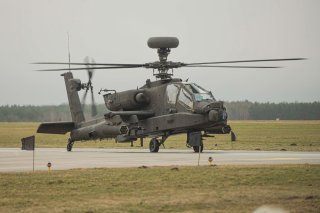Boeing Has Big Plans for the Next Apache Helicopter
Boeing explained that while the previous century of aviation advances saw innovations in what kind of aircraft were developed, the company believes that this century's significant advancements will be related to how aircraft are made.
The Apache helicopter, long the mainstay of U.S. helicopter power, is set to receive significant upgrades and improvements that will keep the aircraft relevant long into the future.
In a press release, Boeing, the firm behind the Apache design, explained that “for more than 35 years, the AH-64 Apache has defended freedom, kept the peace and helped ensure mission success for Soldiers in every corner of the globe — identifying and eliminating wide-ranging, dynamic threats from the battlefield and keeping our ground forces safe.”
The press release added that “from the AH-64A in 1984 to today’s AH-64E Version 6, or v6, the Apache has grown in leaps and bounds — time and again exceeding expectations and redefining the capabilities of the platform. The Apache has proven to be an extremely lethal Attack helicopter platform as well as a very powerful and effective Reconnaissance platform.”
Boeing’s press release explained that the new Apache would incorporate the following six modernization elements:
1. Drivetrain upgrades to unlock Improved Turbine Engine (ITE) capabilities for enhanced power, range, efficiency, and speed;
2. A Modular Open Systems Approach (MOSA) for maximum interoperability, and faster integration and fielding of advanced capabilities;
3. Advanced mission systems to increase interoperability to the network and to reduce pilot cognitive strain and workload during operations;
4. Advanced sensors and sensor fusion for better and more resilient connectivity across domains and operations in all environmental conditions;
5. Airborne long-range precision munitions, Air Launched Effects (ALE) and potential future directed energy weapon system integration for increased lethality;
6. Advanced sustainment through a more capable and lower life cycle cost airframe, as well as affordable remanufacture and minimized procurement costs.
Though the U.S. Army is currently sourcing an aircraft for its Future Vertical Lift program, an initiative that will replace many of the helicopters within the Department of Defense, that program has not yet been finalized and gives the Apache room to grow.
Boeing explained that while the previous century of aviation advances saw innovations in what kind of aircraft were developed, the company believes that this century's significant advancements will be related to how aircraft are made.
Though the Boeing press release did not mention extended wing stubs that can carry more munitions than previous Apache helicopters, concept art released by Boeing appears to show these extended wing stubs.
Still, the limitations of helicopters are increasingly recognized. As part of its Force Design 2030 strategy, the U.S. Marine Corps is turning to the V-22 Osprey, a tiltrotor design, for long-distance hauling and transport.
Still, with these most recent upgrades, the Apache will remain relevant for many years to come.
Caleb Larson is a multimedia journalist and defense writer with the National Interest. A graduate of UCLA, he also holds a Master of Public Policy and lives in Berlin. He covers the intersection of conflict, security, and technology, focusing on American foreign policy, European security, and German society for both print and radio. Follow him on Twitter @calebmlarson.
Image: DVIDS.

